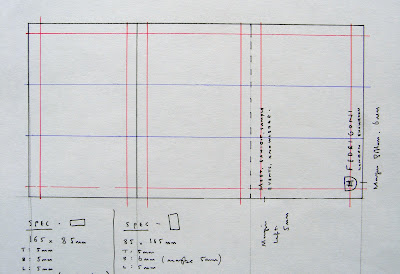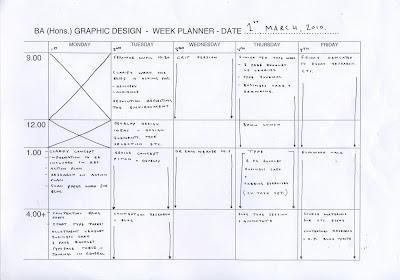My approach to this collaboration was heavily geared toward working alongside someone who would share my desires to experiment within the realms of a print based design practice and be willing to try/test high end print finishing techniques. Against the advice of some, I also tried to seek an individual who offered a similar skill set to that of my own as a means to strengthen my capabilties in print through learning new and relevant aspects that I had perhaps not considered before.
Through collaborating with Chloe I feel that the most significant skills I developed were naturally orientated towards print, with foil blocked invitations and spot varnished promotional posters coming to the forefront of our endeavours. Furthermore, I feel my newly learnt skills in typography and layout allowed me to successfully brand the hypothetical 'Folded' event programme and design the small-scale invitations for its launch.
Perhaps more importantly however, I feel a particular sense of pride in being able to develop a much stronger conceptual approach to the brief as a result of dedicating time to rewriting the original YCN briefs. Lastly, I am also proud of organising and planning the collaborations entire schedule down to the hour most days as documented through timetables and to-do lists/books.
2. What approaches to/methods of research have you developed and how have they informed your design development process?
Secondary research into existing areas of print based design proved to be a useful and prominent resource as with every brief I have progressed with this year. Regarding print however, it was particularly crucial to have existing examples to gauge our ambitions from and in light of this specified stock samples from companies such as Benwells and Fedrigoni also became very important to our progression.
In terms of first hand research methods, trying/testing origami and paper engineering techniques became a very time consuming but necessary process as it was important to experience what a potential customer of Fedrigoni may be willing to engage with as a recipient of the posted package.
Contacting Fedrigoni direct was also a notable step towards clarifying who they were actually trying to target via this brief as their original written description of this aspect was unclear.
3. What strengths can you identify in your work/the collaboration and how have/will you capitalise on these?
My strengths in this collaboration definitely manifested through negotiating ideas with Chloe and making quick decisions in order to keep a flowing momentum in terms of design development. As mentioned before, I also feel that the collaboration significantly benefitted through my time management skills that can be seen through the rigorous production of timetables, to-do lists and schedules.
More so in any other brief that I have completed over my time on the course, I am also very proud of the quality of my product photography and how this transcended into the development of the finalised concept boards submitted to YCN/Fedrigoni. I feel the end product looked very professional and upto the standards of a 2nd year Leeds College of Art design student.
4. What weaknesses can you identify in your work/the collaboration and how will you address these more fully?
An eye opening and problematic experience that I encountered in the latter stages of this collaboration presented itself through the way in which I neglected to consider the abscence of either collaborative memeber in regards to the structuring of mine and Chloe's final week of scheduled work/tasks to-do. To clarify further, although I was diligent in organising what myself and Chloe had to do in the final week before submission, my finalised plans were very un-forgiving and required a lot from both individuals to get everything done. Due to the unfortunate abscence on Chloe's behalf for the last 5 days of the brief, I subsequently put myself under a lot of un-necessary stress; especially in conjunction with the Critical Studies essay that was due in for submission the day before YCN.
Next time I approach a collaboration (or any brief for that matter), I feel that it would definitely be beneficial to time-table in a clear and distinctive 'grace period' that would compensate for any un-forseen circumstances that may arise.
5. Identify five things that you will do differently next time and what do you expect to gain from doing these?
1. Plan for error, mistakes or un-forseen circumstances.
2. Although much improved, continue to blog progress 'as it happens' to avoid playing catch-up.
3. Rehearse concept pitches. This brief proved that a simple concept is not always the easiest to explain.
4. Dedicate more toward persistent contextual research.
5. Document development through photography more consistently.
6. How would you grade yourself on the following areas:
Attendance 5
Punctuality 4
Motivation 5
Commitment 5
Quantity of work produced 5
Quality of work produced 5
Contribution to the group 5
Perhaps more importantly however, I feel a particular sense of pride in being able to develop a much stronger conceptual approach to the brief as a result of dedicating time to rewriting the original YCN briefs. Lastly, I am also proud of organising and planning the collaborations entire schedule down to the hour most days as documented through timetables and to-do lists/books.
2. What approaches to/methods of research have you developed and how have they informed your design development process?
Secondary research into existing areas of print based design proved to be a useful and prominent resource as with every brief I have progressed with this year. Regarding print however, it was particularly crucial to have existing examples to gauge our ambitions from and in light of this specified stock samples from companies such as Benwells and Fedrigoni also became very important to our progression.
In terms of first hand research methods, trying/testing origami and paper engineering techniques became a very time consuming but necessary process as it was important to experience what a potential customer of Fedrigoni may be willing to engage with as a recipient of the posted package.
Contacting Fedrigoni direct was also a notable step towards clarifying who they were actually trying to target via this brief as their original written description of this aspect was unclear.
3. What strengths can you identify in your work/the collaboration and how have/will you capitalise on these?
My strengths in this collaboration definitely manifested through negotiating ideas with Chloe and making quick decisions in order to keep a flowing momentum in terms of design development. As mentioned before, I also feel that the collaboration significantly benefitted through my time management skills that can be seen through the rigorous production of timetables, to-do lists and schedules.
More so in any other brief that I have completed over my time on the course, I am also very proud of the quality of my product photography and how this transcended into the development of the finalised concept boards submitted to YCN/Fedrigoni. I feel the end product looked very professional and upto the standards of a 2nd year Leeds College of Art design student.
4. What weaknesses can you identify in your work/the collaboration and how will you address these more fully?
An eye opening and problematic experience that I encountered in the latter stages of this collaboration presented itself through the way in which I neglected to consider the abscence of either collaborative memeber in regards to the structuring of mine and Chloe's final week of scheduled work/tasks to-do. To clarify further, although I was diligent in organising what myself and Chloe had to do in the final week before submission, my finalised plans were very un-forgiving and required a lot from both individuals to get everything done. Due to the unfortunate abscence on Chloe's behalf for the last 5 days of the brief, I subsequently put myself under a lot of un-necessary stress; especially in conjunction with the Critical Studies essay that was due in for submission the day before YCN.
Next time I approach a collaboration (or any brief for that matter), I feel that it would definitely be beneficial to time-table in a clear and distinctive 'grace period' that would compensate for any un-forseen circumstances that may arise.
5. Identify five things that you will do differently next time and what do you expect to gain from doing these?
1. Plan for error, mistakes or un-forseen circumstances.
2. Although much improved, continue to blog progress 'as it happens' to avoid playing catch-up.
3. Rehearse concept pitches. This brief proved that a simple concept is not always the easiest to explain.
4. Dedicate more toward persistent contextual research.
5. Document development through photography more consistently.
6. How would you grade yourself on the following areas:
Attendance 5
Punctuality 4
Motivation 5
Commitment 5
Quantity of work produced 5
Quality of work produced 5
Contribution to the group 5






















































